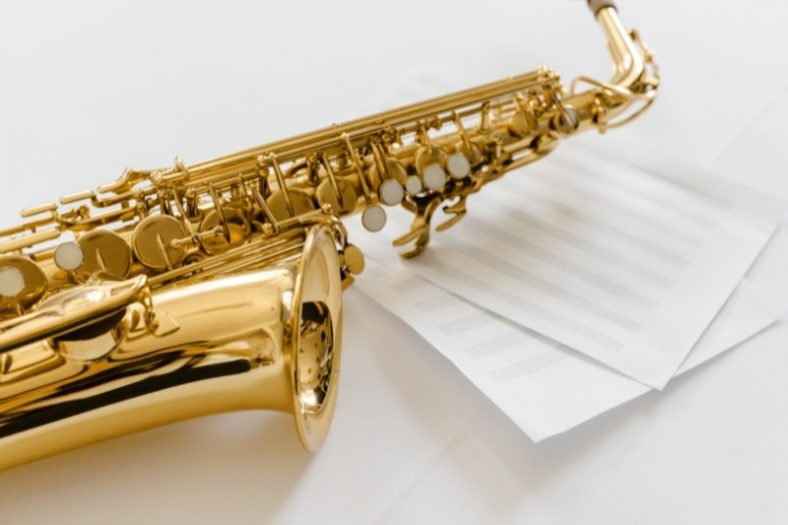Is The Saxophone Hard to Learn?

One of the most important instruments in jazz and classical music, as well as military and marching bands, is the saxophone. It’s a single-reed woodwind instrument with a conical body made of brass. Like many instruments, it is an easy instrument to learn but hard to master.
Many players say it is highly easy to create sounds with the saxophone compared to other wind instruments. But, creating a good sound and playing complex melodies with decent dynamics is quite challenging. In this article, you will find everything you need about learning how to play the saxophone.
Contents
How Hard Is It to Learn the Saxophone?
Typically, the saxophone is not a challenging instrument to learn, especially in the beginning. The reed helps create sounds easier, the lip shape called the embouchure stays the same in each different note, and the notes are changed with keys, which allows you to play simple melodies relatively early on.
The Reed
The saxophone is made of brass but does not belong to the brass instrument family like the trumpet, as the saxophone has a reed, which helps you easily create sounds by blowing. The sound is created with this reed and mouthpiece instead of the buzzing of your lips which is the case in trumpet and other brass instruments.
This aspect makes the saxophone easier to play in the beginning compared to brass instruments because the technique of buzzing the lips for creating sound is quite hard to learn and master.
Embouchure/Mouth Shape
The embouchure is the mouth shape and the blowing angle, which plays a huge role in creating sound and notes with brass instruments. The embouchure of a brass instrument changes with each note, while it stays the same when playing saxophone.
As mentioned, the embouchure of brass instruments is quite hard to master. For example, it is tight and changes with every note when playing the trumpet. Some flutes require the air to be blown at a specific angle for a specific sound, which again is a big challenge for most players.
On the other hand, saxophone players blow into the instrument by putting their lips on the mouthpiece. The angle and the position stay pretty much the same for each note. Just by learning which keys to press and release as the notes are produced with the combination of keys on the instrument, you can play any note on the instrument quite easily.
Changing Notes
The saxophone is one of the easiest instruments to play when it comes to learning notes. Thanks to the keys on the instrument, it is highly easy to learn the combinations of notes and play different melodies. You do not have to change the mouth shape or blowing style for any note.
The saxophone has the octave key, which you can use to reach the higher notes. You don’t have to do anything else for the higher notes, and the note-fingering strategy is the same. You can play the lower notes just by pressing the octave key.
For example, brass instrument players have to target the notes with their lips as well as the keys. Most brass instruments have so many note combinations, and the combinations may change for different octaves. That is not the case with saxophones as knowing just a set of combinations is enough to reach many notes without changing the blowing angle.
How Long Does it Take to Learn the Saxophone?

The time required to play the instrument heavily depends on the individual. Many aspects like daily practice time, motivation, practice style, genetic factors, familiarity with music, and many more play a role. On average, 6 months of practice is enough to play some basic melodies and sax solos.
Again, the saxophone is an instrument that is easy to learn but hard to master. You can learn faster than other instruments in the first few months. But, learning to play the saxophone is an endless journey as there are many maestro players still learning new techniques and skills.
Generally, to master an instrument, there is the 10.000-hour rule. In that case, if you practice for an hour every day, you can master the saxophone in around a year and a half. But of course, every instrument offers an unending journey of exploration and learning. Essentially, the learning process never stops when you play an instrument.
Which Type of Saxophone Should You Get?
Most beginner saxophone players start off learning on the alto or tenor saxophones. As the soprano and baritone saxophones are slightly harder to play and have a few more tricks to learn. The tenor and alto saxophones are ideal for first-time sax players.
The challenge with the soprano saxophone is that playing in tune in the first phase is hard. Although it is a small saxophone, quite easy to handle and play, it is not easy to get used to the tuning.
On the other hand, baritone saxophones require more air to be blown into the mouthpiece as the instrument is quite big. So, it needs more power and dedication to play than the rest of the sax types. Also, the intonation is more difficult in baritone saxophones, giving another challenge to beginner players.
The most important thing when choosing a sax type depends on the likes of the player. If you like the sound of baritone or soprano saxophone more than the others, there is nothing to stop you from starting with one of those. You might have a little challenge in the first few weeks, but you can easily get used to the layout.
However, if you like them all the same, I recommend you go with an alto or tenor saxophone to progress faster. You can switch to another type whenever you want.
The Best Way to Learn Saxophone
The best way to learn to play the saxophone is to work with an instructor and practice as much as you can and as regularly as you can. While these are the golden rules for learning any new skill, with saxophones, they are even more important as it is vital to learn the fundamental skills properly and build up on that to be a good sax player.
The fundamental skills such as embouchure, scales, articulation, dynamic control, and vibrato are the most vital skills which you should learn and apply properly. That is why the saxophone is an easy instrument to learn but a complex instrument to master. After learning the basics of these skills, it comes down to the quality of the application.
To learn the fundamental skills properly, you need an instructor to correct your mistakes and prevent the wrong techniques from engraving into muscle memory. To get the techniques right, you must practice daily as much as possible.
5 Tips to Learn the Saxophone
- Create A Daily Practice Routine: If there is one golden rule when learning to play a new instrument or get a new skill, it is consistency. Practicing regularly allows the new techniques and skills you have learned to be engraved deep in your muscle memory, which means real progress.
- Work With An Instructor: Having a teacher or an instructor makes the learning process much faster, especially if you are working with an experienced instructor. They know which techniques you will struggle with and common mistakes to avoid.
- Practice Breathing: To play the sax successfully, you must masterfully control your breath. The flow of breath needs to be constant, which can only be learned by practicing the throat and the diaphragm. The throat needs to be open and relaxed all the time, while the breathing must be done by the diaphragm.
- Get The Right Saxophone And Equipment: Choosing the right saxophone and equipment is also important. Tenor saxophones are preferred by entry-level sax players who like jazz and rock, as well as alto saxophones for beginner players who want a smaller-size sax. The soprano sax is more advanced, while the baritone sax is the largest one with a powerful sound aimed at experienced players. Besides the sax itself, the choice of the reed, mouthpiece, and ligature are also important. The reeds play important roles in creating sound and offering better playability.
- Clean Your Saxophone Regularly: The saxophones are made of brass, they work with high air pressure, and there are many holes in the instrument. These features indicate that the saxes are big collectors of moisture, grime, debris, bacteria, and any kind of dirt. You should clean your instrument daily if possible to avoid inhaling any bacteria, germs, and dirt. The moisture should always be wiped off the instrument, and a type of oil should be applied to protect it.
How Does a Saxophone Work?
To create a sound with a saxophone, the player blows air at high pressure into the instrument through the mouthpiece. It vibrates the reed attached to the mouthpiece, which creates the sound with the help of the air resonances inside the instrument.
To change the notes, the holes on the instrument are opened or closed, which changes the pitch by altering the length of the instrument. Making the instrument length longer makes the vibration slower, which leads to lower notes. When the holes are opened, the instrument’s length gets shorter, leading to a smaller volume and higher vibration frequency which means higher notes.
Conclusion
The saxophone is a modern instrument that plays a big role in many genres, especially jazz and rock and roll, as well as classical music. It is one of those instruments that are easy to learn but hard to master. The first steps are relatively easy and quick with the instrument, but advanced playing skills are quite challenging and require a lifetime, unending journey of exploring.





